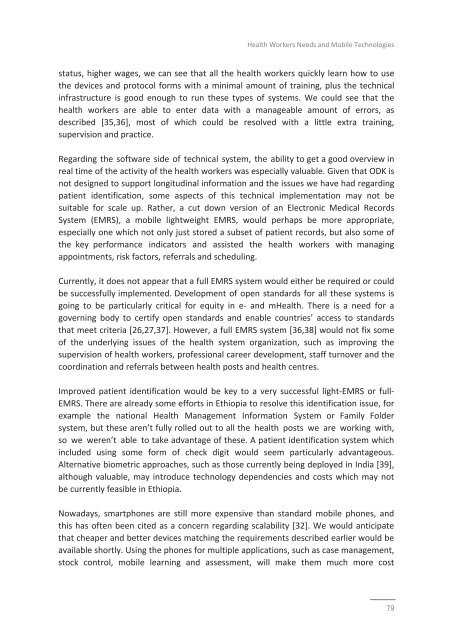araya-thesis
araya-thesis
araya-thesis
You also want an ePaper? Increase the reach of your titles
YUMPU automatically turns print PDFs into web optimized ePapers that Google loves.
Health Workers Needs and Mobile Technologies<br />
status, higher wages, we can see that all the health workers quickly learn how to use<br />
the devices and protocol forms with a minimal amount of training, plus the technical<br />
infrastructure is good enough to run these types of systems. We could see that the<br />
health workers are able to enter data with a manageable amount of errors, as<br />
described [35,36], most of which could be resolved with a little extra training,<br />
supervision and practice.<br />
Regarding the software side of technical system, the ability to get a good overview in<br />
real time of the activity of the health workers was especially valuable. Given that ODK is<br />
not designed to support longitudinal information and the issues we have had regarding<br />
patient identification, some aspects of this technical implementation may not be<br />
suitable for scale up. Rather, a cut down version of an Electronic Medical Records<br />
System (EMRS), a mobile lightweight EMRS, would perhaps be more appropriate,<br />
especially one which not only just stored a subset of patient records, but also some of<br />
the key performance indicators and assisted the health workers with managing<br />
appointments, risk factors, referrals and scheduling.<br />
Currently, it does not appear that a full EMRS system would either be required or could<br />
be successfully implemented. Development of open standards for all these systems is<br />
going to be particularly critical for equity in e‐ and mHealth. There is a need for a<br />
governing body to certify open standards and enable countries’ access to standards<br />
that meet criteria [26,27,37]. However, a full EMRS system [36,38] would not fix some<br />
of the underlying issues of the health system organization, such as improving the<br />
supervision of health workers, professional career development, staff turnover and the<br />
coordination and referrals between health posts and health centres.<br />
Improved patient identification would be key to a very successful light‐EMRS or full‐<br />
EMRS. There are already some efforts in Ethiopia to resolve this identification issue, for<br />
example the national Health Management Information System or Family Folder<br />
system, but these aren’t fully rolled out to all the health posts we are working with,<br />
so we weren’t able to take advantage of these. A patient identification system which<br />
included using some form of check digit would seem particularly advantageous.<br />
Alternative biometric approaches, such as those currently being deployed in India [39],<br />
although valuable, may introduce technology dependencies and costs which may not<br />
be currently feasible in Ethiopia.<br />
Nowadays, smartphones are still more expensive than standard mobile phones, and<br />
this has often been cited as a concern regarding scalability [32]. We would anticipate<br />
that cheaper and better devices matching the requirements described earlier would be<br />
available shortly. Using the phones for multiple applications, such as case management,<br />
stock control, mobile learning and assessment, will make them much more cost<br />
79


